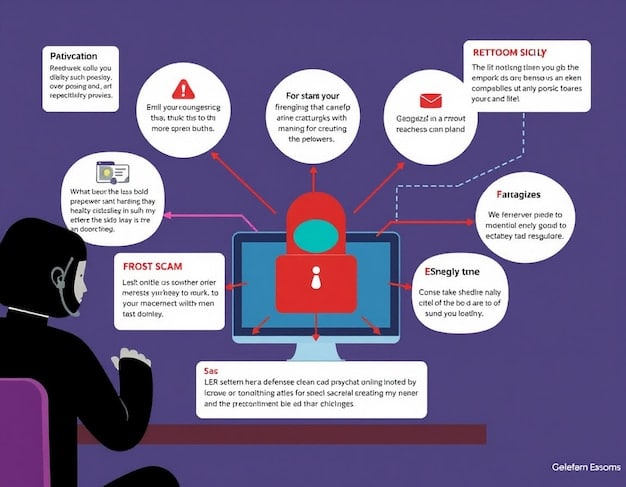New Federal Guidelines on Data Breach Notifications: What US Businesses Need to Know Now

The US government has issued updated federal guidelines for data breach notifications, requiring immediate action from businesses to reassess their cybersecurity protocols, incident response plans, and communication strategies.
In an era where digital threats evolve at an unprecedented pace, proactive measures are no longer optional but imperative. Today, we delve into the critical details of the new federal guidelines on data breach notifications, a development that will significantly impact how organizations in the US manage and report cybersecurity incidents.
Understanding the Evolving Landscape of Data Breach Regulations
The digital domain is a powerful engine for innovation and progress, yet it harbors an ever-growing array of sophisticated threats. Data breaches, once relatively rare occurrences, have become a disturbingly common reality, affecting millions of individuals and organizations annually. This escalation in cyber incidents has compelled regulatory bodies to enhance existing frameworks, aiming to bolster protections and ensure greater accountability. The new federal guidelines represent a pivotal shift in this ongoing effort, reflecting a comprehensive approach to cybersecurity risk management.
Historically, the patchwork of state-specific data breach notification laws created a complex and often confusing compliance environment for businesses operating nationwide. This fragmented regulatory landscape often led to inconsistencies in reporting requirements, notification timelines, and the scope of affected data. The emergence of these federal guidelines seeks to harmonize these diverse requirements, providing a clearer, more unified direction for organizations, even as state laws continue to evolve.
The Imperative for Unified Standards
The move towards unified federal standards is driven by several critical factors. Firstly, the interconnected nature of modern businesses means that a data breach in one state can easily impact individuals across multiple jurisdictions, highlighting the limitations of state-centric regulations. Secondly, a standardized approach simplifies compliance for businesses, allowing them to focus resources on prevention and response rather than navigating a labyrinth of disparate rules. Thirdly, more uniform guidelines enhance consumer protection by ensuring consistent notification practices regardless of where a breach originates or where affected individuals reside.
These new guidelines underscore the government’s recognition of cybersecurity as a matter of national security and economic stability. They are designed to:
- Provide clarity on what constitutes a reportable breach.
- Standardize the timelines for notification to affected parties and regulatory bodies.
- Emphasize the importance of proactive risk assessment and robust security measures.
- Promote a culture of transparency and accountability within organizations.
Embracing these guidelines is not merely about avoiding penalties; it’s about safeguarding brand reputation, maintaining customer trust, and ensuring operational resilience in the face of persistent cyber threats. Organizations that proactively adapt to these changes will be better positioned to mitigate the impact of future incidents and reinforce their commitment to data privacy.
Key Changes and Their Immediate Impact on Businesses
The updated federal guidelines introduce several significant changes that demand immediate attention from businesses across all sectors. These modifications are designed to close loopholes, accelerate notification processes, and expand the scope of what constitutes a reportable event. Understanding these nuances is paramount for ensuring compliance and minimizing potential legal and reputational repercussions. Organizations must move swiftly to integrate these changes into their existing policies and procedures.
One of the most notable changes revolves around the definition of a “data breach” itself. The new guidelines broaden this definition, moving beyond easily identifiable incidents of unauthorized access to explicitly include situations involving accidental exposure of sensitive data, and even certain types of ransomware attacks where data exfiltration may not be immediately apparent but risk of compromise is high. This wider scope means that many incidents previously considered minor or non-reportable may now trigger notification obligations.
Stricter Notification Timelines
Perhaps the most challenging aspect for many organizations will be the stricter notification timelines. While precise figures can vary based on the specific type and severity of data, the general trend is towards significantly shorter windows for reporting. This reduction in time places immense pressure on incident response teams to rapidly:
- Detect and confirm a breach.
- Assess the scope and nature of the compromised data.
- Identify affected individuals.
- Prepare comprehensive notifications.
The previous leeway that allowed companies to conduct lengthy internal investigations before notifying may largely diminish, requiring a more agile and pre-defined response strategy. Failure to comply with these compressed timelines could result in substantial fines and regulatory scrutiny, far exceeding the costs associated with the breach itself.

Furthermore, the guidelines clarify and, in some cases, expand the types of sensitive personal information that, if compromised, trigger a notification requirement. This includes not only financial details and Social Security numbers but also health information (even if not explicitly covered by HIPAA in all contexts), biometric data, and certain types of unique identifiers. Businesses must meticulously catalog the data they collect, process, and store to quickly ascertain if a breach involves information falling under these expanded definitions.
The immediate impact extends beyond technical and legal compliance. It touches upon reputation management, customer relations, and business continuity. A well-executed and timely notification process, even for a potentially damaging event, can help preserve trust and mitigate long-term brand damage. Conversely, delays or inadequate communication can amplify negative perceptions and lead to customer attrition.
Establishing Robust Incident Response Plans Under New Rules
With the tightening of federal guidelines, an effective incident response plan (IRP) transitions from a theoretical document to an indispensable operational blueprint. The new regulations demand not just a plan, but a rigorously tested and continually updated strategy that can be activated at a moment’s notice. Organizations can no longer afford generalized approaches; their IRPs must be granular, specific, and aligned with the new, expedited notification timelines.
The foundation of a robust IRP tailored to the updated guidelines begins with a clear understanding of roles and responsibilities. Every member of the incident response team, from IT security specialists to legal counsel and public relations personnel, must know their precise duties during a breach. This includes detailed protocols for detection, containment, eradication, recovery, and most importantly, post-incident analysis and reporting. The emphasis on speed means that decision-making hierarchies must be streamlined, enabling rapid assessment and execution.
Key Pillars of an Updated IRP
Several critical components form the bedrock of an IRP compliant with the new federal guidelines:
- Rapid Detection Mechanisms: Investing in advanced threat detection systems (e.g., SIEM, EDR, XDR) that can quickly identify suspicious activities and potential breaches is crucial. The earlier a breach is detected, the more time available for a coordinated response and notification.
- Containment and Eradication Strategies: Clear, step-by-step procedures to isolate affected systems and remove the threat are essential. This minimizes the damage and prevents further unauthorized access or data exfiltration, helping to control the scope of the incident.
- Forensic Capabilities: The ability to conduct thorough digital forensics to determine the root cause, extent of data compromise, and identity of affected individuals is paramount for accurate reporting. This may involve internal expertise or the engagement of third-party specialists.
- Communication Protocols: Defined communication channels and pre-approved templates for notifying affected individuals, regulatory bodies, and potentially law enforcement are critical. These must adhere to the new timelines and information requirements set forth by the federal guidelines.
Beyond these technical and procedural aspects, the new rules necessitate a cultural shift towards preparedness. Regular drills and simulations (tabletop exercises and full-scale simulations) are no longer optional best practices but essential components of a compliant IRP. These exercises help identify weaknesses in the plan, train personnel under pressure, and ensure that all stakeholders can perform their roles effectively when a real breach occurs. The goal is to move from reactive crisis management to proactive incident readiness, embedding resilience into the organization’s core operations.
Navigating the Notification Process: Who, What, When, Where
The notification process following a data breach is a complex dance involving multiple stakeholders and strict legal obligations. Under the new federal guidelines, the stakes are higher than ever, demanding precision, transparency, and timeliness. A misstep in this phase can exacerbate the impact of a breach, leading to regulatory fines, lawsuits, and severe reputational damage. Understanding the ‘who, what, when, and where’ of notifications is fundamental for any organization operating in the US.
Who needs to be notified? This extends beyond the directly affected individuals. Organizations may need to inform state attorneys general, federal agencies (such as the FBI, CISA, or FTC, depending on the industry and nature of the breach), and, in some cases, credit reporting agencies. The specific list of entities will depend on the type of data compromised, the number of individuals affected, and the industry sector. For instance, breaches involving healthcare information will have additional HIPAA-related reporting requirements, even as these new federal guidelines provide a broader framework.
What Information Must Be Conveyed?
The “what” of notification is equally critical. Notifications must be comprehensive, clear, and actionable. They generally include:
- A description of the incident, including the date of discovery and the approximate date(s) of the breach.
- The type of personal information involved (e.g., names, Social Security numbers, financial account numbers, health information).
- A general description of the measures the organization has taken to address the breach.
- Advice to individuals on steps they can take to protect themselves (e.g., placing fraud alerts, monitoring credit reports).
- Contact information for the organization (phone number, website) for further inquiries.
- Information about identity theft protection services offered, if applicable.
The language used must be accessible, avoiding overly technical jargon, and provide clear next steps for the affected individuals. Generic notifications are no longer sufficient; personalization, where feasible, can help build trust and demonstrate a genuine commitment to customer welfare.

When must notifications occur? The federal guidelines push for accelerated notifications, often requiring reporting within a narrow window, sometimes as short as 72 hours for initial notifications to specific federal bodies, and slightly longer for individual notifications once the scope is fully determined. This demands that organizations have pre-established communication plans and templates ready to be deployed. Delays can be detrimental and subject to significant penalties. Establishing clear internal metrics for notification readiness is thus essential, including regular drills.
Where do notifications need to be sent? Notifications typically involve direct communication channels such as email or postal mail to affected individuals. For regulatory bodies, online portals, secure email, or official reporting forms are often specified. Businesses must also consider state-specific requirements for public notifications, which might involve press releases or prominent website announcements if a large number of individuals are affected. The geographical scope of the breach dictates the multi-jurisdictional reach of these notifications.
The Role of Third-Party Vendors and Supply Chain Security
In today’s interconnected business world, organizations rarely operate in isolation. The reliance on third-party vendors, suppliers, and service providers is extensive, forming complex supply chains that are critical for modern operations. However, this interconnectedness also introduces significant cybersecurity risks. A data breach originating from a third-party vendor can be just as damaging—if not more so—than a direct breach of an organization’s own systems. The new federal guidelines underscore the critical importance of extending data breach notification responsibilities to the entire supply chain.
The revised regulations make it clear that organizations are not absolved of their responsibilities simply because sensitive data resides with or is processed by a third party. If a vendor experiences a breach that compromises data belonging to your organization or its customers, your organization may still be obligated to notify affected parties and regulatory bodies. This places a renewed emphasis on rigorous vendor risk management and robust contractual agreements.
Strengthening Vendor Relationships and Contracts
Managing third-party risk effectively requires a multi-faceted approach. Organizations must implement comprehensive vetting processes for all potential vendors, assessing their cybersecurity posture, incident response capabilities, and adherence to relevant compliance standards. This initial due diligence should be followed by continuous monitoring and reassessment throughout the vendor relationship. Key steps include:
- Thorough Vendor Assessments: Before engaging with a vendor, conduct in-depth security audits, risk assessments, and request certifications (e.g., SOC 2, ISO 27001). Understand their data handling practices, encryption protocols, and physical security measures.
- Robust Contractual Agreements: Ensure that contracts with third-party vendors explicitly outline cybersecurity responsibilities, data protection clauses, and, critically, data breach notification requirements. These agreements should specify notification timelines, reporting formats, and the vendor’s obligation to assist with forensic investigations and customer communications.
- Regular Audits and Monitoring: Periodically audit vendors, review their security policies, and monitor their compliance with contractual obligations. Establish mechanisms for immediate reporting of any security incidents or vulnerabilities.
- Clear Communication Channels: Develop clear lines of communication with vendors to ensure that any potential or actual breaches are reported to your organization without delay. Time is of the essence under the new federal guidelines.
The implications of a third-party breach extend beyond your direct relationship with the vendor. Such an incident can damage your customers’ trust, leading to business disruption and potential legal liabilities. By proactively addressing supply chain security and embedding these new federal guidelines into vendor management practices, organizations can significantly reduce their overall exposure to data breach risks and ensure a more resilient operational environment.
Future-Proofing Your Organization: Beyond Compliance
Achieving compliance with the new federal guidelines for data breach notifications is a foundational requirement, but true cyber resilience demands going beyond mere adherence. Organizations that aspire to future-proof their operations against an ever-evolving threat landscape must adopt a holistic, proactive, and adaptive approach to cybersecurity. This involves fostering a culture of security, investing in continuous improvement, and anticipating future regulatory and technological shifts.
The journey toward future-proofing begins with recognizing that cybersecurity is not solely an IT responsibility; it is a business imperative that requires engagement from every level of the organization, from the board of directors to every employee. Leadership must champion cybersecurity initiatives, allocating sufficient resources and embedding security considerations into strategic decision-making processes. This top-down commitment ensures that security is perceived as an enabler of business, not merely a cost center.
Adopting a Proactive and Adaptive Security Posture
A “set it and forget it” mentality will inevitably lead to vulnerabilities. Future-proofing necessitates a dynamic security posture that constantly adapts to new threats and technologies:
- Continuous Risk Assessments: Regularly evaluate your organization’s threat landscape, identifying new vulnerabilities and potential impacts. This should include assessments of internal systems, third-party exposures, and emerging attack vectors.
- Employee Training and Awareness: Human error remains a leading cause of data breaches. Regular, engaging, and relevant cybersecurity training for all employees is crucial. Educate staff about phishing, social engineering, and best practices for data handling and password management.
- Advanced Security Technologies: Invest in next-generation cybersecurity solutions that leverage artificial intelligence and machine learning for predictive threat detection, automated response, and enhanced data loss prevention. This includes capabilities like zero-trust architectures and micro-segmentation.
- Scenario Planning and Red Teaming: Conduct regular penetration testing and “red team” exercises, simulating real-world attacks to identify weaknesses in your defenses and response capabilities. Use these findings to refine security controls and incident response plans.
Moreover, organizations should actively monitor the regulatory landscape, anticipating future changes in data privacy and security laws. Engaging with industry groups and legal experts can provide valuable insights into upcoming requirements, allowing for proactive adjustments rather than rushed reactive measures. By embedding security into their DNA and committing to continuous improvement, businesses can not only comply with the new federal guidelines but also build a resilient foundation that protects their assets, reputation, and customers well into the future, turning compliance into a competitive advantage.
Financial and Reputational Consequences of Non-Compliance
The repercussions of failing to adhere to the new federal guidelines on data breach notifications extend far beyond mere administrative inconveniences. Non-compliance can unleash a cascade of detrimental financial and reputational consequences, threatening the very stability and longevity of an organization. In an increasingly interconnected and transparent world, the mishandling of sensitive data and subsequent regulatory breaches can have profound and lasting impacts that resonate across every facet of the business.
Financially, the costs associated with non-compliance can be staggering. Directly, organizations face substantial regulatory fines and penalties. Federal agencies, with enhanced enforcement powers under the new guidelines, are empowered to impose significant monetary penalties for each violation, which can quickly accumulate depending on the scale and duration of the non-compliance. These fines are often calculated per incident or per affected individual, rapidly escalating into millions of dollars. For smaller businesses, such penalties can be catastrophic, leading to bankruptcy or forced closure.
Beyond Fines: The Hidden Financial Burdens
However, regulatory fines represent only the tip of the iceberg. The financial burden of non-compliance also includes:
- Legal Fees and Settlements: Class-action lawsuits from affected individuals are a common outcome of poorly managed breaches. Defending against these lawsuits and potentially reaching large settlements can drain considerable financial resources.
- Credit Monitoring Costs: Organizations are often required to provide free credit monitoring services to affected individuals for several years, a cost that can add up significantly for large-scale breaches.
- Forensic Investigation and Remediation: Inadequate initial response often leads to prolonged and more expensive forensic investigations to understand the full scope of a breach. Remediation efforts to fix vulnerabilities can also be costly.
- Loss of Revenue: Businesses often experience a direct loss of revenue post-breach due to customer churn, loss of new business, and damaged trust. Brand loyalty can erode quickly in the wake of perceived negligence.
- Increased Insurance Premiums: Cybersecurity insurance premiums can skyrocket after a breach, reflecting the increased risk profile of the organization. In some cases, coverage may even be revoked.
Reputationally, the damage can be even more insidious and long-lasting than financial penalties. A breach handled poorly—especially one involving delayed or insufficient notification—can utterly destroy public trust. News of data breaches travels fast, amplified by social media and traditional news outlets. Consumers and business partners are increasingly discerning about where they entrust their data. A tarnished reputation can lead to a significant loss of market share, difficulty attracting and retaining talent, and strained relationships with strategic partners.
In essence, adhering to the new federal guidelines is not just about avoiding punishment; it’s about safeguarding the fundamental health and credibility of an organization. Proactive compliance is an investment in long-term stability and sustained market presence, allowing businesses to maintain their integrity and continue to operate successfully in a highly scrutinized digital landscape.
| Key Point | Brief Description |
|---|---|
| 🔄 Evolving Landscape | New federal guidelines standardize previously fragmented state data breach laws, enhancing consumer protection. |
| ⏰ Key Changes & Impact | Broadened breach definitions and stricter, faster notification timelines demand urgent business adaptation. |
| 🛡️ Robust Response Plans | Organizations need granular, tested Incident Response Plans (IRPs) aligned with new rapid reporting requirements. |
| 🔗 Supply Chain Security | New rules extend accountability to third-party vendors, necessitating enhanced supply chain risk management. |
Frequently Asked Questions About New Data Breach Guidelines
The new federal guidelines aim to address the increasing frequency and sophistication of cyberattacks, standardize fragmented state-level notification laws, and enhance consumer protection across the United States. They seek to provide a clearer framework for businesses, improve accountability, and foster greater transparency in the event of a data compromise, ultimately strengthening national cybersecurity resilience.
The updated definition of a data breach is broader, encompassing not only unauthorized access but also accidental exposure of sensitive data and certain ransomware incidents. This expanded scope means that more types of cybersecurity incidents will now trigger notification obligations, requiring a more comprehensive risk assessment and incident classification approach from organizations.
The guidelines introduce significantly stricter and shorter notification timelines, often requiring initial reports to federal agencies within 72 hours of discovery. Subsequent notifications to affected individuals must also be expedited. This necessitates a highly agile and pre-defined incident response plan capable of rapid detection, assessment, and communication to avoid penalties.
Organizations are now largely responsible for breaches occurring within their supply chain. This means if a third-party vendor handling your data suffers a breach, you may still be obligated to notify affected parties. Robust vendor risk management, strong contractual agreements, and clear communication protocols with all suppliers are consequently more critical than ever.
Non-compliance can lead to severe financial penalties, including substantial regulatory fines per incident or per affected individual. Additionally, organizations face significant reputational damage, customer churn, increased legal fees, potential class-action lawsuits, and higher cybersecurity insurance premiums. Adherence is crucial for maintaining business continuity and public trust.
Conclusion
The introduction of the new federal guidelines on data breach notifications marks a definitive turning point in the landscape of cybersecurity and data privacy for US organizations. These regulations are not merely a bureaucratic formality; they represent a fundamental call to action for businesses to re-evaluate, bolster, and rigorously test their defenses against an ever-present digital threat. From redefining what constitutes a reportable breach to imposing stricter notification timelines and extending accountability across the supply chain, the guidelines demand immediate and comprehensive strategic adjustments. Embracing these changes proactively, by investing in robust incident response plans, diligent vendor management, and a pervasive culture of security, is no longer merely best practice—it is an absolute imperative for safeguarding financial stability, maintaining customer trust, and ensuring long-term operational resilience in an increasingly cyber-conscious world.





